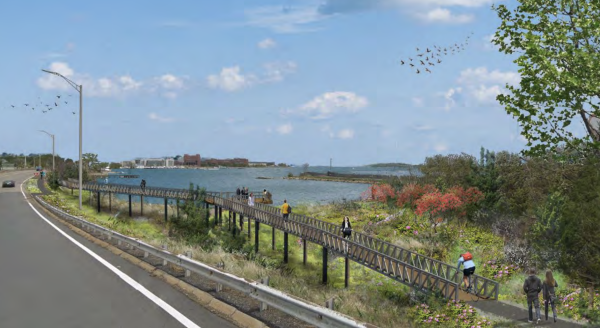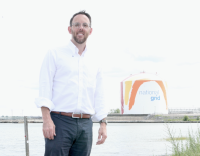August 9, 2023

The future Greenway extension, shown above in a DCF rendering.

On a recent Thursday morning, well past rush hour, cars hurtled down Morrissey Boulevard, as cars coming off I-93 lined up for their turn onto the northbound side of the six-lane roadway.
Cars occasionally turned into a small beach next to the towering National Grid gas tank. The UMass Boston campus sat in the distance, across Dorchester Bay.
While the traffic was moving fast, the work of upgrading a deteriorating, often-flooded Morrissey has been slow, as multiple city and state agencies have struggled to figure out next steps for the major artery. When Marty Walsh, then the mayor of Boston, voiced skepticism about dropping lanes, work slowed even further. A $1 million study remains underway as developers are working on proposals to bring thousands of residential units, and even more thousands of workers in commercial spaces.
Brian Arrigo hopes to speed things up and find funding. The former mayor of Revere, Arrigo in April stepped into the top job at the state Department of Conservation and Recreation, which is overseeing the reconstruction of Morrissey between Mount Vernon Street and Neponset Circle.
Appointed by Gov. Maura Healey and reporting to Environmental and Energy Secretary Rebecca Tepper, Arrigo said they are “really lockstep in thinking about DCR as an agency that sits in the middle of equity, economic opportunity, public health and ultimately climate change.”
He is focused on figuring out how to make Morrissey a priority in that vein. “I know that there’s a tremendous amount of opportunity around thinking of Morrissey through a climate lens, and thinking about how we create a habitat that helps the landscape, and the design of it is a model for green infrastructure, and then also we’re hitting those other markers that we want to hit,” he told the Reporter in a newsroom interview.
Arrigo joined Reporter editors for a walk through the construction area that is just by the I-93 off-ramp, where workers in hard hats drove pilings into the ground as part of a project to build a 3,620-foot long pathway, elevated above the salt marsh and tidal flats that make up the cove. Once complete, the pathway will connect Tenean Beach to Morrissey, and the Neponset River Greenway Trail to the Harborwalk by UMass Boston and all the way downtown.
There have been improvements to Morrissey, such as intersection upgrades. “But there’s a much bigger, grander thought to Morrissey,” Arrigo said, and DCR officials have been in touch with Quentin Palfrey, Healey’s director of federal funds and infrastructure, to ensure the agency is “in line to get every federal dollar that we can.”
He has a personal connection with the roadway, too. “In my head, when I think about Morrissey, I think of the Boston Globe,” he said, referring to 135 Morrissey Blvd., once the headquarters of the daily newspaper, which moved to downtown Boston in 2017. The building, where his late father John worked as a pressman before operations moved to Billerica, is now home to biotechs and a fitness apparel company.
Arrigo recalled visiting his father and seeing the giant presses, which could also be seen from the road. When he was struggling in his first year at Suffolk University, he told his father he was considering following in his footsteps, and making $60,000 to $65,000 a year as a pressman. His father refused and encouraged him to stay in school.
Turning back to the future of the boulevard, Arrigo acknowledged people will have differing opinions. A state commission, created through a transportation borrowing bill last year, was initially due to issue a report on Morrissey last June, but that deadline has been shifted to mid-2024.
“For me, especially having been a municipal official, municipal folks know best what’s going on in their backyard,” Arrigo said. “We may own the properties, and we’re the largest landowner in a lot of different places, but we need to be able to listen to what’s happening. Because if we really truly want to make an improvement in quality of life for the residents, we need to listen to the residents who are most impacted. And, so, I know that there’s been a little bit of history of some of the improvements made or not made here, and if you look at where we’re at, or where we’re headed with some projects, we truly want to have that input at the front end of what we’re doing.”


